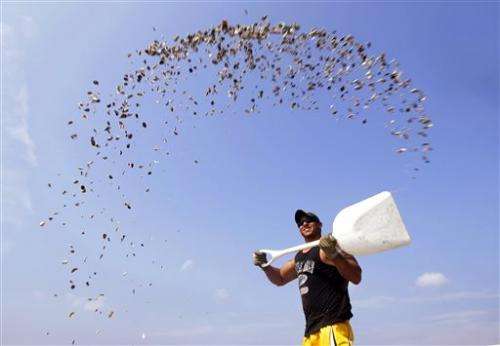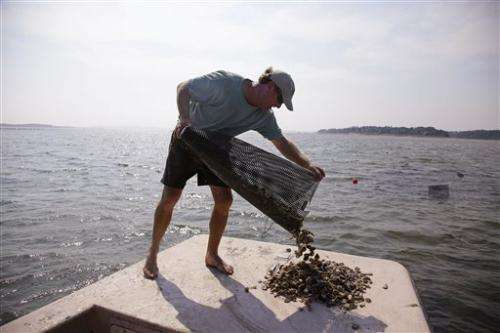Jason Costa, an employee of Merry's Oysters, broadcasts oyster seed from a boat into Duxbury Bay in Duxbury, Mass., Thursday, Sept. 12, 2013. Oyster harvesting on Massachusetts' South Shore has been closed since Aug. 30, 2013 due to bacterial contamination from the Vibrio parahaemolyticus bacteria and may remain closed until mid-October. (AP Photo/Stephan Savoia)
The recent closures of Massachusetts oyster beds due to bacterial contamination have caused angst in the state's small but growing oyster industry.
The culprit is the Vibrio parahaemolyticus (VIB'-ree-oh peh-ruh-hee-moh-LIT'-ih-kus) bacterium, which has occurred in Massachusetts waters since the 1960s. Why it's become a problem now, though, is a mystery.
Average monthly daytime water temperatures in the region rarely approach the 81 degrees believed to be the threshold that triggers dangerous Vibrio growth.
It has been only six years since Massachusetts was required to federally report Vibrio illnesses, so testing to predict and explain the problem is not fully developed.
Oyster cultivator Don Merry pours oyster seed onto the bow of his boat on Duxbury Bay in Duxbury, Mass., Monday, Sept. 12, 2013. Oyster harvesting on Massachusetts' South Shore has been closed since Aug. 30, 2013 due to bacterial contamination from the Vibrio parahaemolyticus bacteria and may remain closed until mid-October. (AP Photo/Stephan Savoia)
The state's first closures were announced Aug. 30 for oyster beds along the shore south of Boston. The second closure, announced Monday, shut down oyster beds in Katama Bay at Martha's Vineyard.
© 2013 The Associated Press. All rights reserved.






















